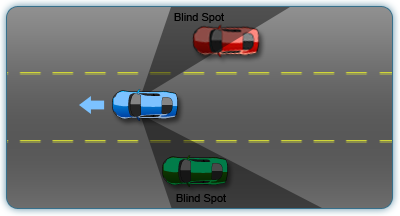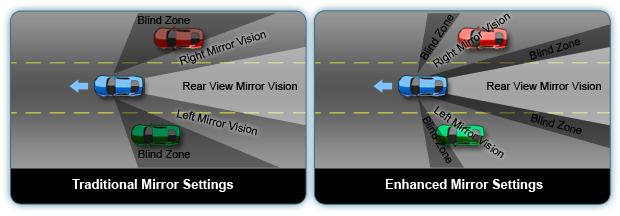How To Check Your Blind Spots
 Blind spots
Blind spots
What is a Blind Spot?
Blind spots are the areas around your vehicle that you can't see within your normal field of vision. You cannot see other vehicles traveling in your left or right blind spots without turning your head and looking over your shoulder.
Just like you can't see other vehicles in your blind spots without looking over your shoulder, other drivers can't see you when you travel in their blind spots. Trucks in particular have much larger blind spots than passenger vehicles. Instead of driving in another driver’s blind spot, you should either pass them or increase the distance between your two vehicles.
How to Check Your Blind Spots
When turning or switching lanes, make sure to check your blind spot for other roadway users. Check your side mirrors, rearview mirrors, and over your shoulder by turning your head and looking behind your shoulder in order to see in your blind spot. Don’t just assume the way is clear. Check and check again! Be patient and wait to leave your lane until you're 100% sure it's clear and safe to do so.
Blindzone Glare Elimination (BGE) Mirror Method
 Blindzone Glare Elimination
Blindzone Glare Elimination
Traditionally, drivers set their side mirrors so they could still see the edge of their car in the mirrors. However, this setting creates large blind spots on either side of the car that are big enough to hide entire vehicles. This creates the need for drivers to turn their heads and glance over their shoulders to check their blind spots before changing lanes, as we discussed above.
Experienced drivers can use the BGE, or Blindzone Glare Elimination. In this method, drivers set their mirrors another 15 degrees out so that they cannot see the edge of their own car at all in the side mirrors. This eliminates large blind spots and also gets rid of the glare of other cars’ headlights in your side mirrors because the following car’s headlights are not visible until they pass into the mini blind spot created by this mirror setting.
Make sure to set your mirrors before your vehicle is in motion. Here's how the BGE mirror method works:
- To adjust the mirror on your left side, place your head against the glass of your window and position the mirror so you can just barely see the edge of your own car in the mirror. This way, when you’re sitting straight up, you won’t be able to see the side of your car at all.
- To adjust the mirror on your right side, put your head in the center of the car and position the mirror so you can just barely see the edge of your car. Again, when you’re in your normal driving position, you won’t be able to see the edge of your car at all.
- Now, sitting in your normal driving position, watch a car as it passes you. You should see it first in your rearview mirror. Before it completely leaves your rearview mirror, it should appear in your side mirror. And before it leaves your side mirror, you should be able to see it in your peripheral vision. Thus, the car that’s passing you should always be visible to you in one of your mirrors or in your field of vision without you having to turn your head and glance over your shoulder.
Make sure you check your inside rearview mirror first, then quickly glance at the outside mirror to check for vehicles in your blind spot. When used correctly, you can briefly glance in your mirrors rather than turning your head to check your blind spot, which means your eyes won't be off the road for quite as long.
This method is also helpful at night because it help eliminate glare from the outside mirrors.
Blind Spot Sensors
Blind spot sensors on newer vehicles can be super helpful when it comes to being aware of your surroundings. Even if your vehicle is equipped with blind spot sensors, you'll still need to visually check that your blind spot is clear before turning or changing lanes. Road conditions can change in the blink of an eye, and technology isn't a replacement for your own two eyes.
Want to learn more about blind spots and other traffic safety topics? We offer online courses including Defensive Driving and Driver Education. Our courses can help you dismiss a ticket, get your driver's license, or even get a discount on your insurance. We also have courses specifically tailored to mature drivers (i.e., drivers age 55 and older) for insurance discounts.